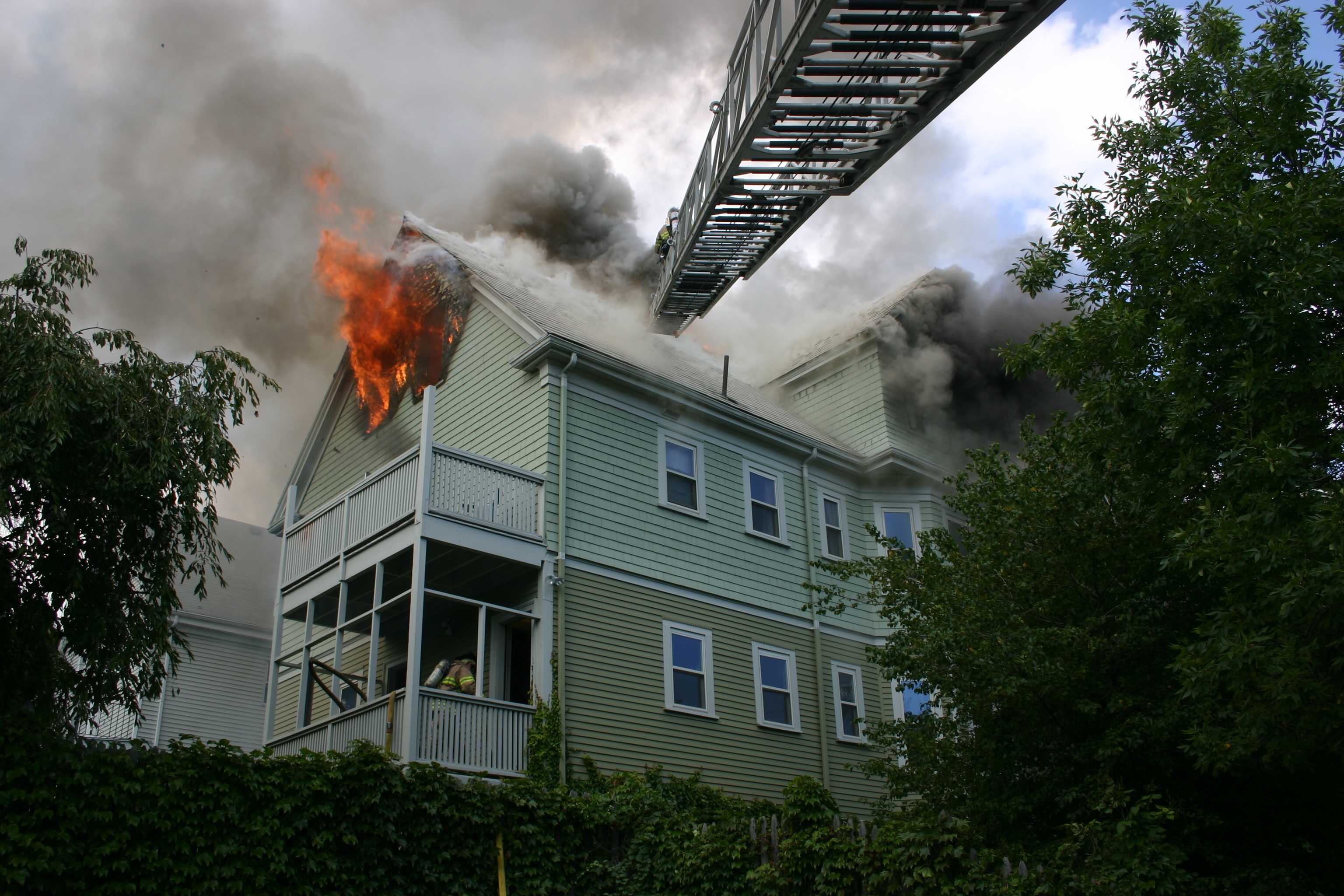NIOSH-funded Program Contributes to a New Massachusetts Law to Protect the Health and Safety of Floor Finishing Workers
June 2011
DHHS (NIOSH) Publication Number 2011-181

A Massachusetts house fire resulting from the use of highly flammable floor finishing products. Photo by Dean Razzaboni.
A Story of Impact:
Wood floor sanding and finishing can be hazardous to workers and building occupants. In Boston, Massachusetts (MA) more than 25 fires were directly attributed to wood floor installation and refinishing from 1995–2004.1 In 2004 and 2005, the MA Fatality Assessment and Control Evaluation (MA FACE) program—funded by the National Institute for Occupational Safety and Health (NIOSH)—investigated two incidents in which a total of three Vietnamese floor finishing workers died when the flammable lacquer sealer they were using caught fire.2,3 The floor finishing industry in MA is largely dominated by the immigrant Vietnamese community.
Alarmed by these deaths, the MA Coalition for Occupational Safety and Health (MassCOSH) mobilized a statewide task force to develop solutions to fire and health hazards associated with floor refinishing. The Task Force included representatives from the Dorchester Occupational Health Initiative (DOHI), the Vietnamese-American Initiative for Development (VIET-AID), labor unions, product distributors, floor finishing companies, and community organizations.4,5 Government agency staff served as advisors. At the time of these fires, DOHI—a project funded by the National Institute of Environmental Health Sciences—was working in Dorchester, Massachusetts to conduct outreach and educational efforts to improve the environmental and occupational health of Vietnamese-American floor finishers and other groups, and thus was able to quickly mobilize a response, release recommendations, and access this community.5
Relevant Information
- Highly flammable materials are often used in the floor finishing process that are easily ignited by heat or sparks from smoking materials, pilot lights, and electrical appliances.
- Lacquer sealers are extremely flammable and provide a low quality finish when used on wood floors.
- Efforts to eliminate the use of highly flammable floor finishing products would prevent worker injuries and fatalities.
Impact
The Task Force members and the MA Toxics Use Reduction Institute held discussions with business owners and product distributors, and conducted field investigations and laboratory testing of a range of products. Based on this input, the Task Force developed a report of policy recommendations that included prohibiting the use and sale of highly flammable wood floor finishing products that can ignite at temperatures less than 100°F and promoting the use of safer floor finishing products through various mechanisms.5,6
The MA FACE program collaborated with the MA Fire Marshal and VIET-AID to develop a Fire Alert, available in Vietnamese and English, about floor finishing products.7 VIET-AID collaborated with DOHI and MA FACE to develop and promote culturally and linguistically appropriate training materials on safer products and practices. VIET-AID provided five hour-long trainings in Vietnamese to 146 wood floor finishers in the use of safer products, and spearheaded a media campaign reaching out to the Vietnamese community through newspaper, radio and television to raise awareness of the dangers of floor finishing products.
As a result of these efforts, the MA Board of Fire Prevention Regulations in April 2010 passed a new regulation requiring individuals applying floors finishing products with flashpoints below 100°F to obtain permits from the fire department and to post warning signs on all doors/entrances of buildings where the highly flammable products are to be used.8 The regulation also require extinguishing ignition sources before using these products and until the product has completely dried.8 Furthermore, in July 2010, the MA Governor signed into law a landmark state bill banning the sale and commercial use of highly flammable lacquer sealers with flashpoints below 100°F.9 These policy changes are vital steps forward in protecting the safety and health of floor finishing workers.
View/Download Entire Document: NIOSH-funded Program Contributes to a New Massachusetts Law to Protect the Health and Safety of Floor Finishing Workers [PDF - 1,479 KB]




Visit the NIOSH FACE program Web site (www.cdc.gov/niosh/face) or the MA FACE Web site (www.mass.gov/dph/face) for more information.
References
1 Boston Fire Department Press Release. Safety Bulletin: Hazards Associated with Hardwood Floor Refinishing. September 15, 2004.
2 Fatality Assessment and Control Evaluation (FACE) Program, National Institute for Occupational Safety and Health, Centers for Disease Control and Prevention, U.S. Department of Health and Human Services. Two Vietnamese Floor Sanders Die When Wood Floor Finish Product Ignites. Massachusetts Case Report: 04-MA-032. 2006. Available at: http://www.cdc.gov/niosh/face/stateface/ma/04ma032.html. Accessed: May 16, 2011.
3 Fatality Assessment and Control Evaluation (FACE) Program, National Institute for Occupational Safety and Health, Centers for Disease Control and Prevention, U.S. Department of Health and Human Services. Floor Sander Dies When Wood Floor Refinish Product Ignites. Massachusetts Case Report: 05-MA-044. 2006. Available at: http://www.cdc.gov/niosh/face/stateface/ma/05ma044.html. Accessed: May 16, 2011.
4 Massachusetts Coalition for Occupational Safety and Health (MassCOSH). Protecting Workers and Homeowners from Floor Finishing Hazards. 2008. Available at: http://www.masscosh.org/node/76. Accessed: May 16, 2011.
5 Azaroff, L, Doan, T, Nguyen, H, Goldstein-Gelb, M, Fraser-Cook, M, Kota, S. Protecting workers and residents from wood floor-finishing hazards. New Solut. 2006;16(2):119-38.
6 Massachusetts Coalition for Occupational Safety and Health (MassCOSH). Protecting Workers and Homeowners from Wood Floor-Finishing Hazards in Massachusetts. 2005. Available at: http://www.masscosh.org/files/ProtectingFromFloorFinishingHazards.pdf. Accessed: May 16, 2011.
7 Occupational Health Surveillance Program of the Massachusetts Department of Public Health, Office of the State Fire Marshal of the Department of Fire Services. Wood Floor Sanders Killed When Floor Finishing Product Catches Fire—Massachusetts. Fire Safety Alert. 2006. Available at: http://www.mass.gov/Eeohhs2/docs/dph/occupational_health/wood_floor_sanders.pdf. Accessed: May 16, 2011.
8 Massachusetts Coalition for Occupational Safety and Health (MassCOSH). New Floor Finishing Regulations Approved. 2010. Available at: http://www.masscosh.org/node/466. Accessed: May 16, 2011.
9 Massachusetts Coalition for Occupational Safety and Health (MassCOSH). Landmark state bill banning deadly floor sealer signed into law. 2010. Available at: http://www.masscosh.org/node/556. Accessed: May 16, 2011.
SAFER • HEALTHIER • PEOPLE™
- Page last reviewed: June 6, 2014
- Page last updated: June 6, 2014
- Content source:
- National Institute for Occupational Safety and Health Education and Information Division


 ShareCompartir
ShareCompartir